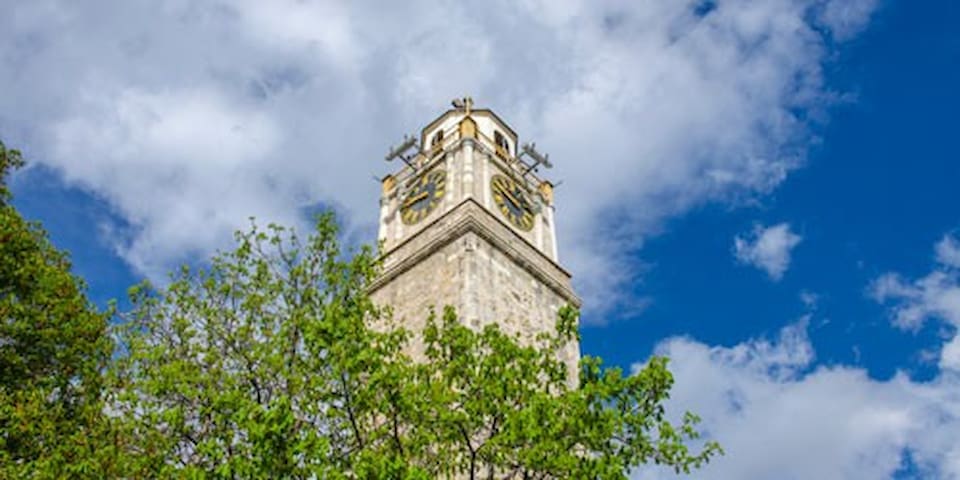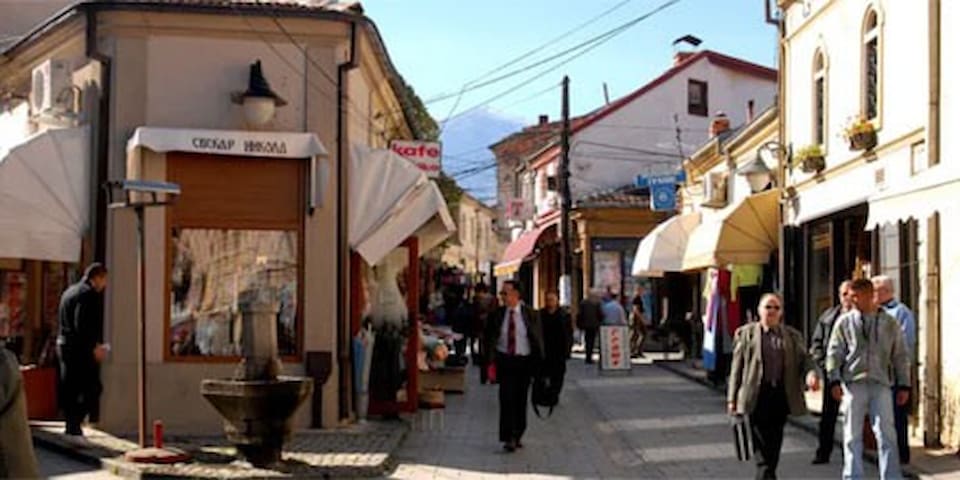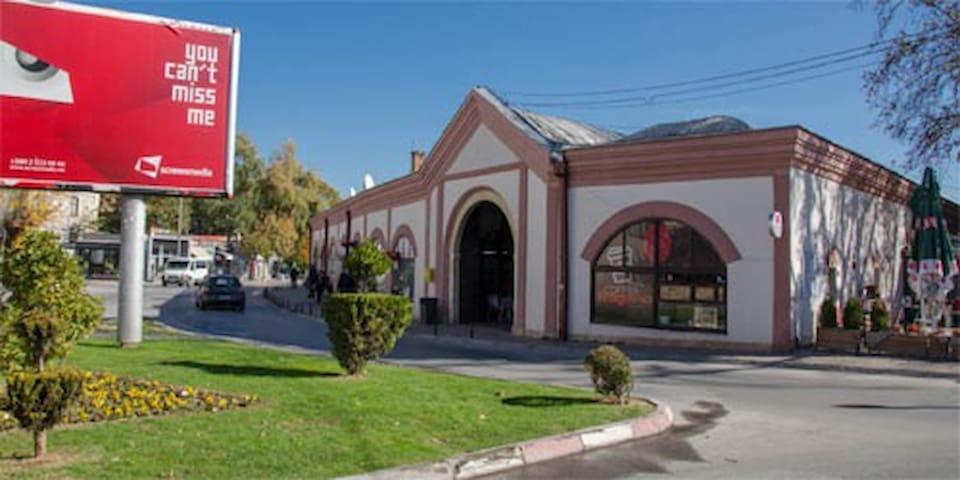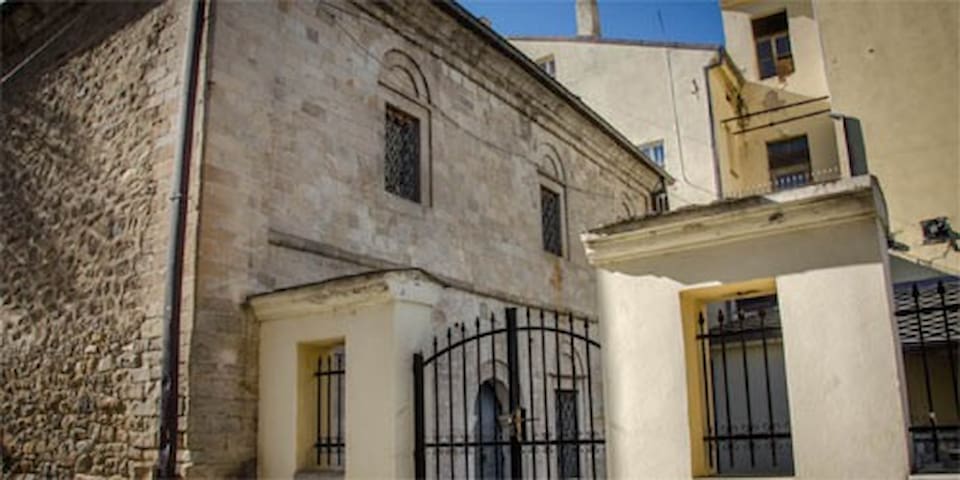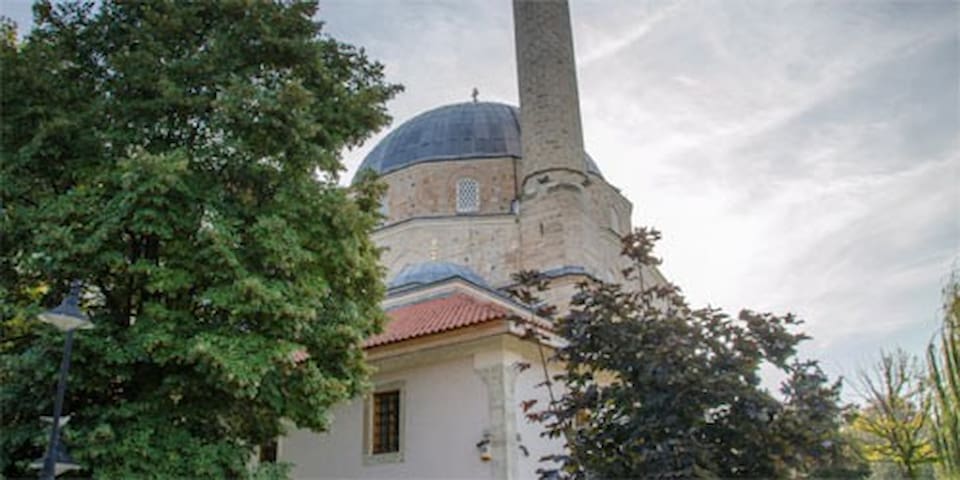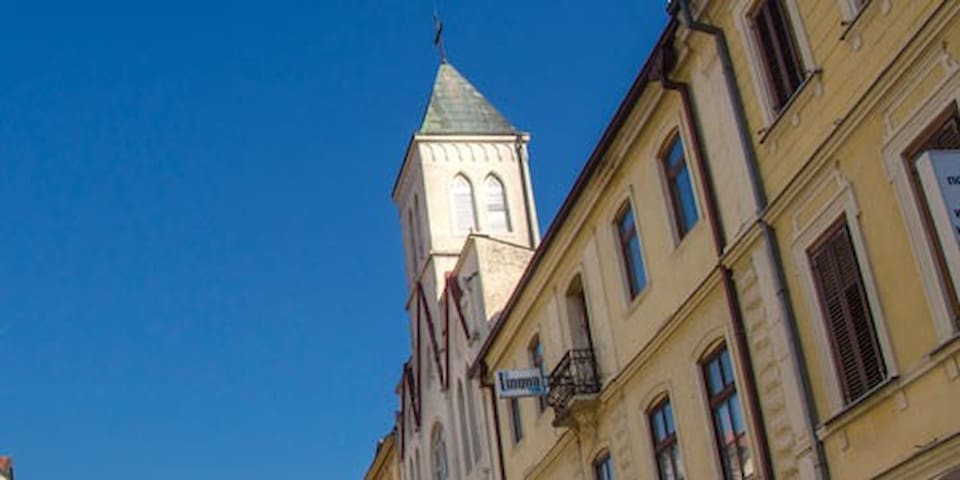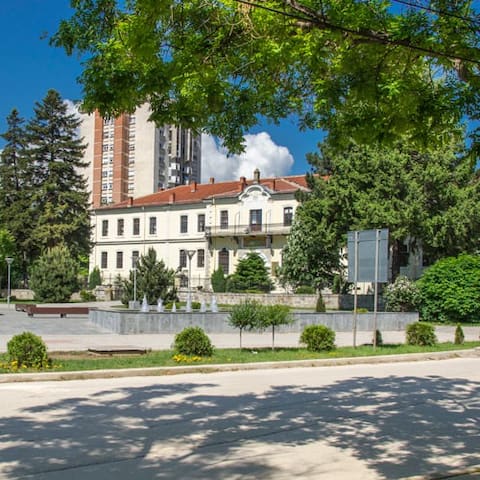Sightseeing
At only 1 minute walk from Viktorija Rooms is the most famous church in Bitola, dedicated to St. Dimtrij
St. Demetrius of Solun
At only 1 minute walk from Viktorija Rooms is the most famous church in Bitola, dedicated to St. Dimtrij
At 150 m (1 min walk) from Viktorija Rooms
Every building has its own story that is passed from one generation to the other. Its truthfulness is never checked because the stories are supposed to be narrated. The only unsolved story about this Clock Tower is the story about the 60.000 eggs that the Turkish administration collected from the population, so they could be used for its building, so it could be firmer and stronger.
The sounds of the bells, the music, are spread through the air, through the small park filled with beauty. New loves, new sympathies are woven into its base, because it is the only one who knows how the secrets are supposed to be kept.
A wonderful but simple story isn’t it?
According to the legends, even though the existence of the Clock Tower was mentioned before in the 17th century, present Clock Tower was built in the 1830’s, in the same period when nearby, the Orthodox Church of St. Demetrious was built.
It was built with massive stone blocks. The main, and in the same time the most decorative part of the Clock Tower, is the part where the clock itself is placed, one on each of the four sides.
The entrance into the Clock Tower is on the north side of the tower, and it is encircled by big marble blocks. Approximately a hundred stairs leads to the clock, to its peak about 32meters high. On each of the stairs new information, new transformation begins. Those stairs lead to the top from where in the past the big metal bells sounded, indicating the precise time. In 1927, a new numbers and the first clock mechanism made by the German Company “Konfage” were placed, and some additional changes were made. The individuals in charge to ring the bells were replaced with “sajzii” which were in charge to take care of the clock and the clock mechanism. The first clock face was white with black numbers and hands, and it was smaller than the present one. This clock mechanism was changed in 1936, when 15 new bells, about 900 heavy ones, were placed there. They were a sign of gratitude for the building of the Memorial Cemetery of the German soldiers who died during the First World War.
In 1962, the mechanism was renewed, and in 1970 for the performance of new compositions, the piano was placed inside the tower. This Clock Tower is one of the 180 towers in the world which has built on this kind of mechanism. The music compositions make it even more unusual. Every six hours one of six compositions is played: “Bitola Babam Bitola”, “Biljana platno belese” etc.
This Clock Tower is not only a symbol of the time that passes by unstopping but it is a symbol of the magnificence of Bitola and her survival. The hands are moving as a sign of the past but the present time too.
6 locals recommend
Clock Tower
Jorgo OsmanoAt 150 m (1 min walk) from Viktorija Rooms
Every building has its own story that is passed from one generation to the other. Its truthfulness is never checked because the stories are supposed to be narrated. The only unsolved story about this Clock Tower is the story about the 60.000 eggs that the Turkish administration collected from the population, so they could be used for its building, so it could be firmer and stronger.
The sounds of the bells, the music, are spread through the air, through the small park filled with beauty. New loves, new sympathies are woven into its base, because it is the only one who knows how the secrets are supposed to be kept.
A wonderful but simple story isn’t it?
According to the legends, even though the existence of the Clock Tower was mentioned before in the 17th century, present Clock Tower was built in the 1830’s, in the same period when nearby, the Orthodox Church of St. Demetrious was built.
It was built with massive stone blocks. The main, and in the same time the most decorative part of the Clock Tower, is the part where the clock itself is placed, one on each of the four sides.
The entrance into the Clock Tower is on the north side of the tower, and it is encircled by big marble blocks. Approximately a hundred stairs leads to the clock, to its peak about 32meters high. On each of the stairs new information, new transformation begins. Those stairs lead to the top from where in the past the big metal bells sounded, indicating the precise time. In 1927, a new numbers and the first clock mechanism made by the German Company “Konfage” were placed, and some additional changes were made. The individuals in charge to ring the bells were replaced with “sajzii” which were in charge to take care of the clock and the clock mechanism. The first clock face was white with black numbers and hands, and it was smaller than the present one. This clock mechanism was changed in 1936, when 15 new bells, about 900 heavy ones, were placed there. They were a sign of gratitude for the building of the Memorial Cemetery of the German soldiers who died during the First World War.
In 1962, the mechanism was renewed, and in 1970 for the performance of new compositions, the piano was placed inside the tower. This Clock Tower is one of the 180 towers in the world which has built on this kind of mechanism. The music compositions make it even more unusual. Every six hours one of six compositions is played: “Bitola Babam Bitola”, “Biljana platno belese” etc.
This Clock Tower is not only a symbol of the time that passes by unstopping but it is a symbol of the magnificence of Bitola and her survival. The hands are moving as a sign of the past but the present time too.
People in Bitola say:
“If you were in Bitola and you haven’t walked through Main Street - Shirok Sokak, then you have seen nothing.”
Širok Sokak (Широк Сокак – Wide Street) is the main and busiest street in Bitola, with numerous shops and bars. Located in the city center, as the local population says, this is the place where you go if you want to see someone in Bitola or to be seen.
On Sirok Sokak are located many shops, bars, restaurants, the theater, city museum, galleries, and cafes.
Shirok Sokak
Shirok SokakPeople in Bitola say:
“If you were in Bitola and you haven’t walked through Main Street - Shirok Sokak, then you have seen nothing.”
Širok Sokak (Широк Сокак – Wide Street) is the main and busiest street in Bitola, with numerous shops and bars. Located in the city center, as the local population says, this is the place where you go if you want to see someone in Bitola or to be seen.
On Sirok Sokak are located many shops, bars, restaurants, the theater, city museum, galleries, and cafes.
At 290 m (4 min walk) from Viktorija Rooms
Only a few decades ago if you walked from the Wood Market (Drven Pazar) to the Horse Market (At Pazar), the narrow stone paved streets would lead you through 30 markets. Each of them echoed with a special sound. The coldness of the stone clanged with the warm voices of the masters – jokers and their helpers – witty. The older and younger, advices and instructions.
Every stone of those stone-paved streets, thousands of times a day feels the foreign steps, hurrying to steal a bigger part of the day. The horses trot, the camels and the wooden carts, loaded with the most beautiful products from Vienna, Paris, Istanbul, the Far East, with their cracking cuts through the air, so pleasant…
As one of the most important manufacturing centres in Macedonia, and in the larger region too, during the 19th century, over 140 types of crafts and professions existed and flourished in Bitola. All of them were located in 30 different markets, different alleys, grouped in different craftsmen associations, with their own administrative bodies. At Pazar (Horse Market), Ovci Pazar (Sheep Market), Zitni Pazar (Grain Market), Mas Pazar (Cream Market), Pekmez Pazar (Jam Market), Drven Pazar (Wood Market) and many more will welcome you with a wide open arms. You will be called by the tavern and restaurant owners, to get some rest and to get some food. The boza – vendors and the salep – vendors will sweeten you, and you will be welcomed by the markets and tradesmen.
The Old Bazaar, with approximately 900 stores, was the vein of the city where everything was created and everything was sold. There you could fill the life of Bitola. Numerous craftsmen and professions dictated the tempo of life, of all the population of the city, as well as of the surrounding places.
The hammer strikes, the machine sounds, the glow of gold and silver thread that shines from the shop – windows, tempts with their beauty.
The market days were noisy, filled with trade’s sophistry and buyer’s disapprovals. But anyway they all ended in a common pleasure. The wooden stores with a wooden window – shutters, burned down in fires, were rebuilt and changed with new ones, firmer, and closed with metal window-shutters. The closing of the shutters was a moment of temporary calmness and preparation for the next day.
And while the tailors, shoe-makers, goldsmiths and others manufacturers are leaving on a deserved rest, through the bazaar you could hear the sound of the musicians and the peace that slowly prevailed late in the night was disturbed by the bread – makers, tavern – owners and others, with the scent of freshly baked bread and food were awaking the new day.
And a new day, the same, but different than the previous one.
The window-shutters still exist, but they are not hiding former craft – shops, they keep the contemporary equipped stores. With their sound they bring the morning, and with their sound they announce the evening. They awake the curiosity and they look for the noise of those that remained the last.
The bell – makers, the hat-makers, the slipper – makers, the broom – makers across from the candle – makers, “locum – makers”, and others. The last ones as a symbol of the material and spiritual unbreakable connection between life and death.
Stara Charshija
At 290 m (4 min walk) from Viktorija Rooms
Only a few decades ago if you walked from the Wood Market (Drven Pazar) to the Horse Market (At Pazar), the narrow stone paved streets would lead you through 30 markets. Each of them echoed with a special sound. The coldness of the stone clanged with the warm voices of the masters – jokers and their helpers – witty. The older and younger, advices and instructions.
Every stone of those stone-paved streets, thousands of times a day feels the foreign steps, hurrying to steal a bigger part of the day. The horses trot, the camels and the wooden carts, loaded with the most beautiful products from Vienna, Paris, Istanbul, the Far East, with their cracking cuts through the air, so pleasant…
As one of the most important manufacturing centres in Macedonia, and in the larger region too, during the 19th century, over 140 types of crafts and professions existed and flourished in Bitola. All of them were located in 30 different markets, different alleys, grouped in different craftsmen associations, with their own administrative bodies. At Pazar (Horse Market), Ovci Pazar (Sheep Market), Zitni Pazar (Grain Market), Mas Pazar (Cream Market), Pekmez Pazar (Jam Market), Drven Pazar (Wood Market) and many more will welcome you with a wide open arms. You will be called by the tavern and restaurant owners, to get some rest and to get some food. The boza – vendors and the salep – vendors will sweeten you, and you will be welcomed by the markets and tradesmen.
The Old Bazaar, with approximately 900 stores, was the vein of the city where everything was created and everything was sold. There you could fill the life of Bitola. Numerous craftsmen and professions dictated the tempo of life, of all the population of the city, as well as of the surrounding places.
The hammer strikes, the machine sounds, the glow of gold and silver thread that shines from the shop – windows, tempts with their beauty.
The market days were noisy, filled with trade’s sophistry and buyer’s disapprovals. But anyway they all ended in a common pleasure. The wooden stores with a wooden window – shutters, burned down in fires, were rebuilt and changed with new ones, firmer, and closed with metal window-shutters. The closing of the shutters was a moment of temporary calmness and preparation for the next day.
And while the tailors, shoe-makers, goldsmiths and others manufacturers are leaving on a deserved rest, through the bazaar you could hear the sound of the musicians and the peace that slowly prevailed late in the night was disturbed by the bread – makers, tavern – owners and others, with the scent of freshly baked bread and food were awaking the new day.
And a new day, the same, but different than the previous one.
The window-shutters still exist, but they are not hiding former craft – shops, they keep the contemporary equipped stores. With their sound they bring the morning, and with their sound they announce the evening. They awake the curiosity and they look for the noise of those that remained the last.
The bell – makers, the hat-makers, the slipper – makers, the broom – makers across from the candle – makers, “locum – makers”, and others. The last ones as a symbol of the material and spiritual unbreakable connection between life and death.
At 230 m (2 min walk) from Viktorija Rooms
In the morning, in the centre of the city near the banks of the River Dragor, four big metal doors open to the world of beauty. A luxury calls out from every store.
Silk, gold thread and other precious fabrics wrap around the body, shrouding the body.
Bezisten (Covered Bazaar)
In the evening the doors close down, keeping and hiding in its bosom the beauties, the richness…
And so on day after day, till today….
Listening to the sound of the river, feeling the wind in the face, it stands alone. Separated from its core, separated from the Bazaar it becomes a silent witness of the time that passed by.
Situated near the city centre, the Bezisten is one of the most impressive and oldest buildings in Bitola from the Turkish period. With its numerous cupolas that look like a fortress, with its tree-branch-like inner streets and four big metal doors it is one of the biggest covered markets in the region.
It was built in the 15th century by the Rumelian Beglerbey, the Grand Vizier and the famous donor Kara Daut Pasha Uzuncarsili. Although this object looks very secure, many times during its existence it was robbed and set on fire, but it managed to endure. The Bezisten, from the 15th until the 19th century, was rebuilt and many stores, often changing over time, were located there. Most of them were selling textile and other luxurious fabrics. In the same time the Bezisten was a treasury, where in specially made small rooms the money from the whole Rumelian Vilaet was kept, before it was transferred in the royal treasury. In the Bezisten in the 19th century there were a total of 84 stores. Today most of them are contemporary and they sell different types of products, but no matter what the internal transformations, the outer appearance stayed unchanged.
Bezisten
BezistenAt 230 m (2 min walk) from Viktorija Rooms
In the morning, in the centre of the city near the banks of the River Dragor, four big metal doors open to the world of beauty. A luxury calls out from every store.
Silk, gold thread and other precious fabrics wrap around the body, shrouding the body.
Bezisten (Covered Bazaar)
In the evening the doors close down, keeping and hiding in its bosom the beauties, the richness…
And so on day after day, till today….
Listening to the sound of the river, feeling the wind in the face, it stands alone. Separated from its core, separated from the Bazaar it becomes a silent witness of the time that passed by.
Situated near the city centre, the Bezisten is one of the most impressive and oldest buildings in Bitola from the Turkish period. With its numerous cupolas that look like a fortress, with its tree-branch-like inner streets and four big metal doors it is one of the biggest covered markets in the region.
It was built in the 15th century by the Rumelian Beglerbey, the Grand Vizier and the famous donor Kara Daut Pasha Uzuncarsili. Although this object looks very secure, many times during its existence it was robbed and set on fire, but it managed to endure. The Bezisten, from the 15th until the 19th century, was rebuilt and many stores, often changing over time, were located there. Most of them were selling textile and other luxurious fabrics. In the same time the Bezisten was a treasury, where in specially made small rooms the money from the whole Rumelian Vilaet was kept, before it was transferred in the royal treasury. In the Bezisten in the 19th century there were a total of 84 stores. Today most of them are contemporary and they sell different types of products, but no matter what the internal transformations, the outer appearance stayed unchanged.
Yeni Mosque in Bitola is located in the city center on the right side of the River Dragor near the Clock Tower. It was built by Kadi Mahmud Effendi in 1558-59, and in Bitola is known as Yeni (Turkish for – New) Mosque.
The base of the mosque is square, covered with a dome. Next to the mosque is a minaret, which reaches a height of over 40 m.
Yeni Mosque
b.b. Shirok SokakYeni Mosque in Bitola is located in the city center on the right side of the River Dragor near the Clock Tower. It was built by Kadi Mahmud Effendi in 1558-59, and in Bitola is known as Yeni (Turkish for – New) Mosque.
The base of the mosque is square, covered with a dome. Next to the mosque is a minaret, which reaches a height of over 40 m.
Magaza cultural center in Bitola is gallery exhibition space in which many temporary exhibitions or various events are held throughout the year.
During Turkish time, the “Magaza” (Storehouse) represented true haven for traders who brought their wares in Bitola.
Through these gates passed, were stored, exhibited and sold a variety of goods intended not only for the local but also for the major European markets.
Magaza
б.б. 27th of MarchMagaza cultural center in Bitola is gallery exhibition space in which many temporary exhibitions or various events are held throughout the year.
During Turkish time, the “Magaza” (Storehouse) represented true haven for traders who brought their wares in Bitola.
Through these gates passed, were stored, exhibited and sold a variety of goods intended not only for the local but also for the major European markets.
Isak Mosque – largest and main mosque in Bitola
Built in 1506, the whole mosque complex was ideally situated between the government buildings, covered bazaar Bezisten and the Big Bridge to the other side of the river connecting it with the main street Sirok Sokak.
Ishak Chelebi Mosque
b.b. Boulevard 1st of MayIsak Mosque – largest and main mosque in Bitola
Built in 1506, the whole mosque complex was ideally situated between the government buildings, covered bazaar Bezisten and the Big Bridge to the other side of the river connecting it with the main street Sirok Sokak.
The Catholic Church “Sacred Heart of Jesus” is located in Bitola city center on the main street Shirok Sokak.
The Sacred Heart of Jesus
63 Shirok SokakThe Catholic Church “Sacred Heart of Jesus” is located in Bitola city center on the main street Shirok Sokak.
The permanent exhibit is among the largest in the country and is a must see for every visitor of Bitola. Within the museum the memorial room of Mustafa Kemal Ataturk is located
NI Institute and Museum Bitola
The permanent exhibit is among the largest in the country and is a must see for every visitor of Bitola. Within the museum the memorial room of Mustafa Kemal Ataturk is located
At 2.4 km (1.49 mi) from Viktorija Rooms
As soon as you make the first step trough the narrow streets of Heraclea the history and the past will unfold under your feet. The name of Heraclea Lyncestis inevitably brings each of us century’s back, in the period of the 4th century B.C., when this city was founded by Fillip II. Situated on one of the most important crossroads in that time, Via Egnacia (via Egnatia), Heraclea became the most important station in the region.
7 locals recommend
Heraklea Lynkestis
At 2.4 km (1.49 mi) from Viktorija Rooms
As soon as you make the first step trough the narrow streets of Heraclea the history and the past will unfold under your feet. The name of Heraclea Lyncestis inevitably brings each of us century’s back, in the period of the 4th century B.C., when this city was founded by Fillip II. Situated on one of the most important crossroads in that time, Via Egnacia (via Egnatia), Heraclea became the most important station in the region.


